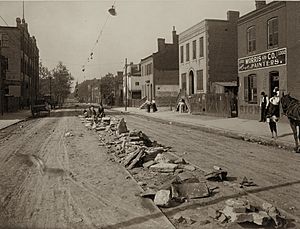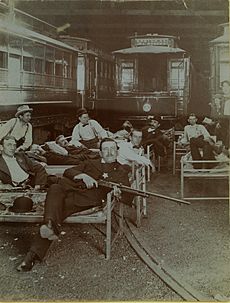St. Louis streetcar strike of 1900 facts for kids
Quick facts for kids St. Louis streetcar strike |
|||
|---|---|---|---|
| Date | May 9, 1900 – September 14, 1900 | ||
| Location | |||
| Methods | Striking | ||
| Parties to the civil conflict | |||
|
|||
| Lead figures | |||
|
|||
| Number | |||
|
|||
| Casualties | |||
| Death(s) | 14 | ||
| Injuries | 200 | ||
The St. Louis streetcar strike of 1900 was a big event where workers stopped working. They were protesting against the St. Louis Transit Company. About 3,000 workers, who were part of a union called the Amalgamated Street Railway Employees of America, went on strike.
This strike lasted from May 7 to September. During this time, 14 people died and 200 were hurt. It was a very difficult period for the city.
Why the Strike Happened
Before 1899, there were ten different companies running streetcars in St. Louis. St. Louis was one of the biggest cities in the United States back then. In 1899, these ten companies joined together to form two larger ones. One of these was the St. Louis Transit Company, led by a man named Edwards Whitaker.
The workers at both streetcar companies faced tough conditions. They worked very long hours, earned low pay, and their workplaces were not good. Because of this, they decided to form a union called Local 131. They hoped to get better treatment.
However, Edwards Whitaker, the head of the St. Louis Transit Company, did not like this. He quickly fired all 3,300 of his workers. To keep the streetcars running, he got help from the St. Louis Metropolitan Police Department. About a thousand police officers volunteered to drive the streetcars.
Trouble in the City
On May 9, the first day of the strike, newspapers reported widespread trouble across St. Louis. The striking workers tried to stop the streetcar service. They cut electric cables, started small fires, and piled rocks and other things onto the tracks.
Many people in St. Louis belonged to unions. Many working-class citizens supported the strikers. They helped shut down the streetcar lines in their own neighborhoods. This showed their support for the workers.
On May 29, Whitaker's own lawyer wrote about the growing problems in the city. He said that a streetcar, without lights, was filled with armed men. These men fired into a building where some striking workers were gathered. Several people on the streets were hurt, even though there was no reason for the shooting. Similar events happened later, with armed men hurting citizens who were not even part of the strike. These actions were carried out by people armed by the company.
The Police Board then gathered 2,500 citizens to form a special group called a posse comitatus. This group was led by John H. Cavender, a local real estate agent. He had been involved in similar situations before. On June 10, members of this posse shot and killed three strikers who were returning from a picnic. Fourteen other strikers were wounded. Many eyewitnesses said the strikers were not armed, which was different from what the sheriff claimed.
The strikers also tried to use dynamite three times. They aimed for the buildings where the temporary workers (who had replaced the strikers) were living. However, these attempts were not successful. On July 2, Whitaker agreed to hire the workers back and let them form a union. But then, he changed his mind and broke the agreement.
What Happened After
The strike slowly ended in September. The tired workers did not gain much from it.
However, the strike did lead to some important changes in St. Louis. A young lawyer named Joseph W. Folk helped the striking workers. He later became the city prosecutor and worked to fight corruption in the city government. By 1904, he became the Governor of Missouri.
This desire for change also led to the election of Mayor Rolla Wells, who promised reforms. A writer named Lincoln Steffens also wrote about the corruption in St. Louis. His articles, published in McClure's magazine in 1902, were some of the first examples of muckraking journalism. This type of journalism investigates and exposes corruption.
Edwards Whitaker, the head of the streetcar company, continued to be a successful businessman in St. Louis. In 1910, he became the president of Boatmen's Bank.
Similar streetcar strikes happened in other cities, like Cleveland in 1899 and Indianapolis in 1913. St. Louis streetcar workers went on strike again in 1918.
Images for kids





